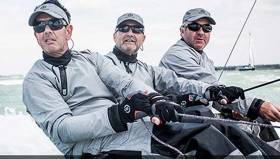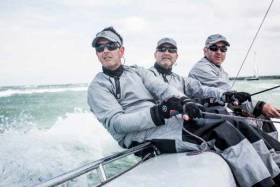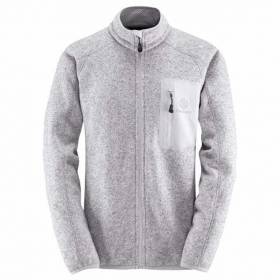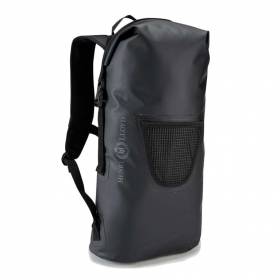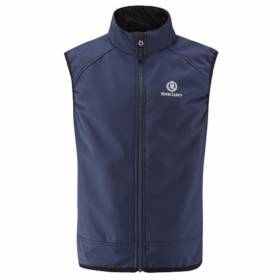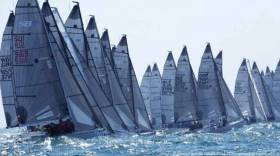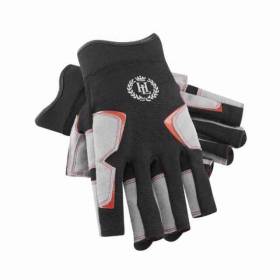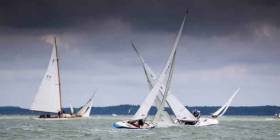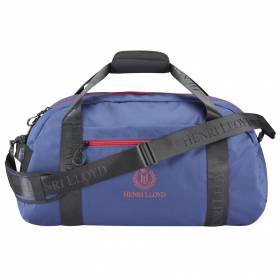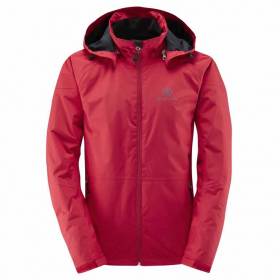Displaying items by tag: Henri Lloyd
Henri Lloyd to Launch New Performance Range Next Spring
This summer marine clothing firm Henri Lloyd was acquired by the Swedish company, Aligro Group.
Since the beginning of July, a new Brand Headquarters has been established in Gothenburg, Sweden. After a period of silence in the market during which the new organisation has been working at full speed, a whole new Performance range will be launched in the Spring of 2019.
In addition to the Swedish team a core UK team has been retained and is led by Country Manager Graham Allen, with further key recruits being announced in the near future;
“It has been a challenging turnaround to go from just over 60 people to four with all that entails following the administration”; says Graham Allen.
“However the new UK team is strong and is well prepared for the task of re-introducing the new brand concept into the UK market. Ross Partridge is Sales Manager for the Performance ranges whilst Lauren Baxendale is responsible for the brands retail business. Tori Tomlin was the Technical Product Manager and is heavily involved in Product Development alongside the new international design team in Sweden ensuring that the Henri Lloyd quality DNA is ever present.
"a whole new Performance range will be launched in the Spring of 2019"
In addition, we have started the recruitment process for a talented and experienced head of sales to reposition the brand in the apparel market.”
Magnus Liljeblad, CEO of the Henri Lloyd Group says: “In future we believe in a Global distribution and as such we must develop products where the markets and customers are, if we and our retail partners are to be successful.
Central to our strategy is a strong belief that we need a new type of pro-active relationship with a smaller number of key retailers. This new relationship is built on mutual collaboration and ensuring that the consumer enjoys an excellent brand experience. We see this smaller network of dealers selling the new Henri Lloyd concept, being much more successful than the old model, where many re-sellers sold principally at a discount.
It is no secret that the marine clothing sector and its associated wholesale business has undergone major change worldwide and it appears that that trend will continue. One of the anticipated consequences is that the number of retailers will reduce significantly in the coming years
Our market analysis is strong and tells us that there is a large market potential for customised sailing garments that allow crews to create their own identity. For too many years now, when you attend a regatta or round the cans mid-week racing you simply see clothing in a small range of colours dominated by shades of black and grey with technical clothing from many brands looking too similar.
We strongly believe that we should break that trend and there are many opportunities to grow in the one design and dinghy markets by relooking at everything from design, fit, fabrics, colours and other ways of customisation that Henri Lloyd is uniquely placed to deliver.
The new collection launching in 2019 comprises 25 styles for men and women and will showcase the new direction. The new approach has been focussed on delivering desirable, new and innovative ideas which will break the perception of Henri Lloyd products feeling outdated. These new products are adapted for one design sailing, keel boats and Super Yachts and will cover the climatic needs of both Northern European and Mediterranean sailors.
“In 2020 we will launch a complete new dinghy programme that will meet the needs from grassroots level to the elite sailor”; Says Ross Partridge Sales Manager Performance at Henri Lloyd UK.
“The new international team is committed to relaunching a focussed and rejuvenated brand. At the heart of this process has been the search for talented designers and developers who will create product that customers really want to buy and will give the brand a clear point of difference. It is a project we very much believe in and we are very happy to announce that the new Henri Lloyd will return in 2019
Henri Lloyd’s New Sailing Clothing Collection for 2018
Born out of our experience of working with some of the World's leading racing teams including Land Rover BAR and Wild Oats, Henri Lloyd marine clothing has been developed through years of collaborative testing where weight, performance, protection and comfort are all essential components to success.
This new evolution of product design, fabric technology and unique features has been designed to match a new generation of high performance racing boats from Fast 40’s down to one design.
Henri Lloyd’s Shadow 3D Race Jacket, Smock & Salopette racing range is a new generation of superior one design racing shell technology, which is been designed with the benefit of stretch for additional performance. Constructed using Henri Lloyd’s own fabric TPR, a highly breathable, water and wind proof fabric which further benefits from a salt water resistant DWR coating which helps to shed surface water and maintain the performance of the garment.
The fit of the jacket has been articulated to reduce windage, the design also incorporates stretch panels across the shoulder panel and at the elbow for increased ease of movement. New for Henri Lloyd, the jacket also incorporated a zip off hood with hi-vis center panel, whilst the quick drying rentex mesh inner collar lining offers protection to the face. The asymmetric water resistant front zip features a drainage channel.
The Shadow 3D Race Smock offers a completely new design to the traditional smock and its design properties are a direct result of our partnership with Land Rover BAR. The smock also benefits from stretch panels and the shoulder and elbow, whilst the asymmetric front zip and neck closure system offers a more superior fit. The placement of the fast draining side access stow pocket means that you have access to the pocket even when wearing a buoyancy aid.
The Shadow 3D Race Salopettes incorporates stretch shoulder panels and further benefits from Velcro tab shoulder adjusters which offer a more personalised fit, recent development and new technologies in fabric reinforcements has resulted in HENRI-PROTEC; a heat applied waterproof film which is proven to be more durable than its predecessors and maintains the durability of the garment for longer.
Henri Lloyd's New Traverse Fleece Jacket
The Henri Lloyd Traverse Jacket is available in both men’s and women’s sizes and styles; the jacket is constructed from a premium knitted fleece which provides simultaneous warmth and a stylish look.
The jacket’s attributes include a high level of stretch and breathability, whilst its superior wicking qualities when combined with excellent thermal properties makes this fleece perfect for cooler temperatures as a mid layer or just as stylish on shore piece.
Henri Lloyd Traverse products provide high performance thermal insulation without weight or bulk. The 2 way stretch marl knits offer super low pilling properties whilst the advanced fabric surface creates air pockets that trap air and retain body heat. Ideal as mid layer, the inner and outer surface textures have been carefully selected to reduce interlaying binding and work with your base and outer layers rather than against them.
The Traverse has a flattering ergonomic seam detail with side and sleeve panels and a zipped chest pocket (which is on the arm for the ladies styles) with moulded zip pullers. It also features a bound hem and cuff, and flat lock seaming for smooth lines and comfort. The full front zip offers ease of donning and option for increased venting.
The Henri Lloyd range is available from leading Irish chandleries such as CH Marine and Viking Marine
Henri Lloyd Dri Pac Collection 2018
New for 2018, Henri Lloyd has designed and developed a new collection of waterproof luggage known as the Dri Pac collection.
The collection features a 5L, 20L and 40L dry bag and also a 25L rucksack version.
These durable and functional bags have been designed specifically with space saving in mind. Constructed from a light yet tough 100 % waterproof polyester PVC with waterproof seams, the bags also features dry roll closure system, this bag is the perfect companion to take onboard a racing yacht when space is at a premium. The bags all features a grab handle and also an over the shoulder single strap carry option.
The Dri Pack rucksack features adjustable, padded shoulder straps and a chest strap which delivers an easy carry method when you need your hands for your other sailings bits and pieces, the rucksack also benefits from a handy front mesh pocket.
Once your sailing kit is removed from the bag, simply squeeze out the excess air, and you’re left with a non-bulky bag for easy stowage.
In Ireland, Henri Lloyd's Dri Pac collection is available from leading chandleries including Viking Marine and CH Marine
Soft Shell performance From Henri Lloyd Cyclone Jackets
A firm sailing clothing favorite within the Henri Lloyd range, the Cyclone Collection of products offer all the benefits of Soft Shell performance with the additional benefit of lightweight thermal insulation.
Henri Lloyd’s 2 layer Soft Shell fabric comprises of a durable face, bonded to a lightly brushed and high wicking fleece back that when combined creates a both highly water/ wind resistant and extremely breathable layer. This fabric allows you to stay comfortable in warmer conditions or during periods of activity, equally the water and wind protection combined with the brushed back allows warming air to be retained during cooler conditions to maintain comfort and provide insulation.
The jacket features which are characteristic to Henri Lloyd include;
· Quick drying mesh inner collar and front body lining.
· Stretch binding to top collar and hem.
· Welded side pockets.
· Secure zip fastening internal pocket.
· Reflective trim to front and back shoulder seams and pockets.
· Moulded hook and loop external wrist adjusters.
· Differential hem with shockcord adjustment.
· Articulated for ease of movement.
The Henri Lloyd Cyclone Collection is available in a Men’s jacket and a vest from leading Irish chandleries such as CH Marine and Viking Marine
Marine clothing brand Henri Lloyd has announced its support of this year’s SB20 World Championships, being hosted by the Royal Yacht Squadron in Cowes this August.
The partnership will see competitors benefiting from an exclusive Henri Lloyd Privilege Club that will be available to all competing members. The organising team behind the World Championships will also benefit from the partnership through the provision of the latest in Henri Lloyd technical apparel.
As the official Technical Clothing Partner, Henri Lloyd will provide the opportunity for competing crews to purchase exclusive SB20 World Championship branded apparel at the Henri Lloyd store in Cowes over the course of the event.
“We are thrilled to be supporting such an exciting fleet of race boats and look forward to watching some close and exciting racing.” Paul Strzelecki - Henri Lloyd Chairman.
This annual event will see up to 100 boats from over 15 nations descend on the stunning venue of Cowes for this highly competitive event.
“We are delighted to welcome Henri Lloyd as the official Technical Clothing Partner for the SB20 World Championships this year. As one of the pinnacle events in the SB20 calendar, we thank Henri Lloyd for their generous support of the Class” Joe Llewellyn, Chairman of the Organising Committee.
The SB20 World Championships will offer the Class five days of intensive racing with two to three races per day, providing an action packed week of competitive racing, prize giving will wrap up the weeks events with a party on Friday 1st September.
Henri Lloyd Launches 2017 Glove Collection
Glove design is a very specialist area and Henri Lloyd has developed their 2017 range focusing on ergonomics and the use of specialist fabric technology to deliver durability, performance, grip and dexterity.
The Henri Lloyd Pro-Grip Glove, available in both long and short fingered, is constructed from tough yet flexible fabrics and components including Kevlar® thread, the superior grip is provided via MAXGRIP technology which is a sticky synthetic rubber, delivering higher levels of grip and articulation whilst also offering protection against rope burn, an additional benefit is that the MAXGRIP is resistant to water absorption.
Kevlar® thread is used throughout for maximum strength and durability, the gloves also feature a neoprene wrist band, combined with a double touch and close strap. The back of the gloves are constructed from a nylon stretch mesh which offers maximum flexibility and fast drying properties. Development within our 2017 glove collection has resulted in new design features including an articulated wrist design for better watch visibility and pull tabs on the short fingered versions for ease of removal.
Also new for 2017, is the Henri Lloyd Deck Grip Glove; available in both long and short fingered versions.
The Deck Grip Glove provides excellent protection and durability with increased articulation via the use of flexible fabrics and components. Quick drying Amara® synthetic leather is used to provide extra reinforcement and protection at the palm and fingers, as with our new glove design for 2017, the Deck Grip glove benefits from the double touch and close wrist strap, articulated wrist design and pull tabs.
For colder conditions, Henri Lloyd has developed the Henri Lloyd Neoprene Winter Glove. The combination of the thermal and water resistant properties of Neoprene with the added benefit of the MAXGRIP technology on the palms and fingers makes them the ideal choice for winter sailing. The gloves also feature a double cuff system for integration into a waterproof top or wetsuit.
The gloves are available from selected Irish chandleries such as Viking Marine and CH Marine
Premium British marine and lifestyle clothing brand, Henri Lloyd, has announced a partnership with the Charles Stanley Direct Cowes Classics Week.
Henri Lloyd will join the family of day sponsors and also become the Official Technical Clothing Partner to the event.
As part of the sponsorship, Henri Lloyd will be working alongside the regatta organisers to provide a bespoke crew kit package of Henri Lloyd’s latest inshore race apparel to all entrants. In addition crews will benefit from a Henri Lloyd ‘pop up’ shop which will be located daily within the Royal London Yacht Club where a bespoke personalisation service will be on offer.
Tuesday 18th July will be known as the Henri Lloyd Race Day, and as part of the day’s celebrations, the Henri Lloyd trophy will be awarded to the overall winner.
“We are delighted to announce our partnership with such an iconic classic yacht regatta, and we will look forward to meeting the crews and watching some exciting racing.” comments Paul Strzelecki, Henri Lloyd Chairman.
Henri Lloyd's Sailing Holdall Is a Breeze
New for 2017, the Henri Lloyd Breeze Sailing Holdall has been designed for the everyday traveller, both on land and on water and combines technical performance alongside everyday features.
Offering 50L of storage the bag has been construction from highly durable polyester, the bag features an internal silver lining which offers increased internal visibility. Whilst additional storage is offered via the two internal stow pockets and a handy external zipped pocket for ease of access. Transportation of the bag can be offered via a detachable adjustable padded shoulder strap, neoprene grab handles and also padded grab handles at either end of the bag.
An additional feature is the incorporation of loop for telescopic handle insertion.
The Breeze Holdall is available in a fresh colour palette, including marine, grey, new red and lime and priced at €65 from CH Marine and Viking Marine
Henri Lloyd 'Cool Breeze Jacket' is Light & Simple
The Henri Lloyd Breeze concept in sailing jackets is stunningly simple, says Henri Lloyd's Shane Cronin – when the weather dictates that you don’t need traditional foul weather gear but you need to stay dry and protected from the wind and spray – this is the answer.
The Henri Lloyd Cool Breeze Jacket is a combination of light insulation and wet weather protection for inshore sailing and everyday use.
An extremely versatile and light weight all year around jacket, which is constructed from Henri Lloyd’s highly durable, waterproof, windproof and breathable TP1 fabric, the jacket also features a micro fleece lining to aid insulation and a zip off hood.
The jacket has been contoured to provide a comfortable fit and to reduce windage, while the side and internal zip fastening pockets provide secure storage.
Available from Irish stockists CH Marine and Viking Marine at €185


























